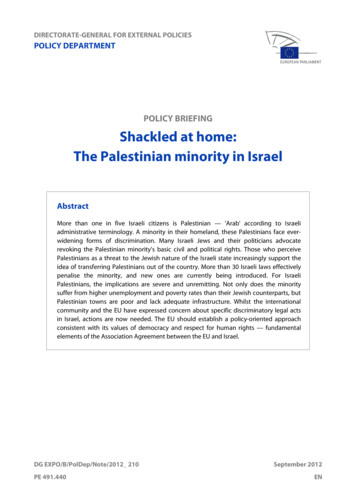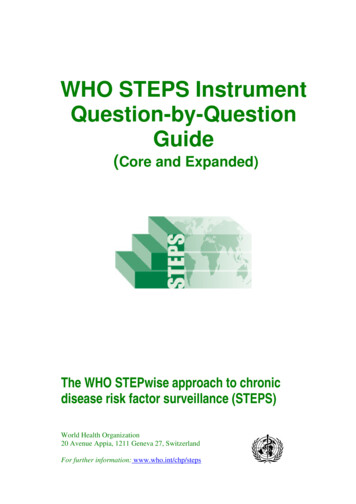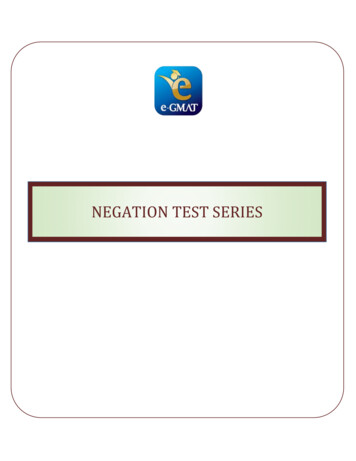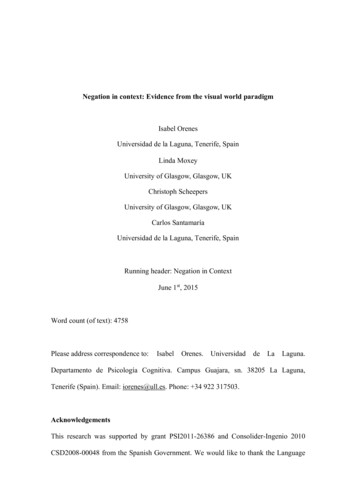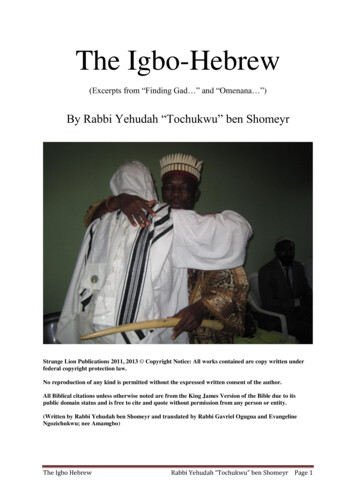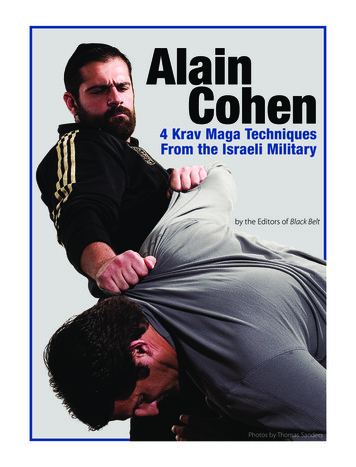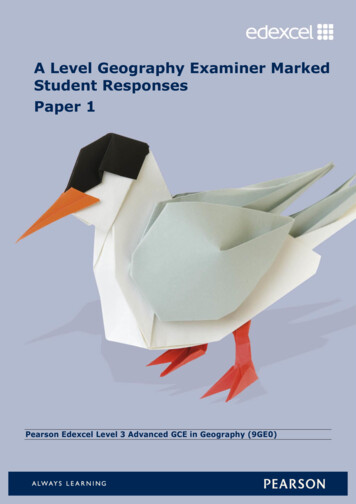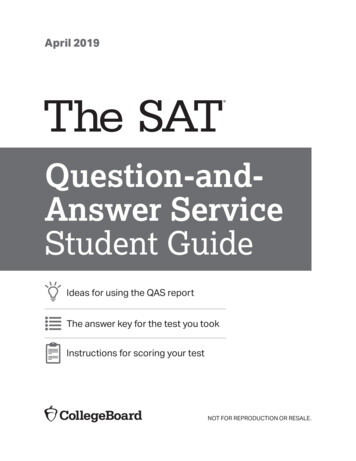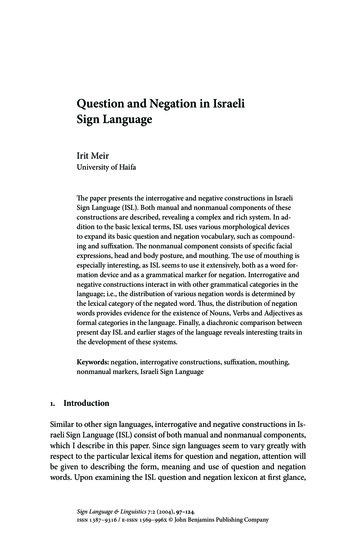
Transcription
Question and Negation in IsraeliSign LanguageIrit MeirUniversity of HaifaThe paper presents the interrogative and negative constructions in IsraeliSign Language (ISL). Both manual and nonmanual components of theseconstructions are described, revealing a complex and rich system. In addition to the basic lexical terms, ISL uses various morphological devicesto expand its basic question and negation vocabulary, such as compounding and suffixation. The nonmanual component consists of specific facialexpressions, head and body posture, and mouthing. The use of mouthing isespecially interesting, as ISL seems to use it extensively, both as a word formation device and as a grammatical marker for negation. Interrogative andnegative constructions interact in with other grammatical categories in thelanguage; i.e., the distribution of various negation words is determined bythe lexical category of the negated word. Thus, the distribution of negationwords provides evidence for the existence of Nouns, Verbs and Adjectives asformal categories in the language. Finally, a diachronic comparison betweenpresent day ISL and earlier stages of the language reveals interesting traits inthe development of these systems.Keywords: negation, interrogative constructions, suffixation, mouthing,nonmanual markers, Israeli Sign Language .IntroductionSimilar to other sign languages, interrogative and negative constructions in Israeli Sign Language (ISL) consist of both manual and nonmanual components,which I describe in this paper. Since sign languages seem to vary greatly withrespect to the particular lexical items for question and negation, attention willbe given to describing the form, meaning and use of question and negationwords. Upon examining the ISL question and negation lexicon at first glance,Sign Language & Linguistics 7:2 (2004), 97– 24.issn 1387–9316 / e-issn 1569–996x John Benjamins Publishing Company
98Irit Meirit might seem more restricted than it turns out to be on closer inspection. Thereason for this is that there are several pairs or even triplets of signs whichare quite similar yet distinct, both semantically and formationally. For example, there are three negative-imperative signs, which differ from each other insubtle ways. The same holds for the negative-completive and the negative-pastsigns, as well as the two negative existential signs. A careful and precise investigation of these forms reveals the differences between them, and the richnessof the system.In addition to the basic lexical terms, ISL uses various morphological devices to expand its basic question and negation vocabulary. Of particular interest are the use of compounding to create new question words, and the useof a negative suffix, glossed as -not-exist, which derives adjectives such asimportant not-exist ‘unimportant’ and interesting not-exist ‘uninteresting’.The nonmanual component consists of specific facial expressions, headand body posture, and mouthing. The use of mouthing is especially interesting, as ISL seems to use it extensively, both as a word formation device and asa grammatical marker for negation. All three nonmanual components interactwith each other in various ways.Interrogative and negative constructions interact in interesting ways withother grammatical categories in the language. For example, the distribution ofvarious negation words is determined by the lexical category of the negatedword. Some negators can co-occur with verbs only, while others are used tonegate nouns or adjectives. Thus, the distribution of negation words providesevidence for the existence of Nouns, Verbs and Adjectives as formal categoriesin the language.Finally, I present some documentation concerning these constructions inearlier stages of the language and provide a brief diachronic comparison.2. Interrogative constructionsThe formation of interrogative constructions in Israeli Sign Languages makesuse of several mechanisms: lexical items (question words), word order andnonmanual markers. Polar interrogatives (yes/no) employ only the latter, thatis, they differ from declarative sentences merely by the use of a specific facialexpression. Content questions (wh-questions) are formed by using questionwords, which tend to come in a particular position in the sentence, as well
Question and Negation in Israeli Sign Languageas certain nonmanual features. I begin with an investigation of the lexicon ofquestion words — their meaning, use and formation (2.1), and then turn toexamine the nonmanual component involved in interrogative constructions(2.2).2. Question wordsISL has a basic paradigm of question words, comprised of six signs. This basiclist is expanded by the use of two formational means: mouthing of Hebrewquestion words accompanying the manual signs, and complex word formation. Another word formation mechanism, initialization, has been introducedinto Signed Hebrew, a contrived system designed to represent Hebrew manually. Though these invented signs have not found their way into ISL proper,some signers may, nevertheless, use them, especially when talking to hearingpeople. In addition to these word formation mechanisms, some non-interrogative signs function as questions in specific contexts. The basic question words,coupled with the forms derived by the above devices, constitute the questionword vocabulary of ISL.2. . The basic paradigmThe basic question words are presented in Table 1.Table . The basic paradigm of question signs in thisExampleswho index3 who?‘Who is it?’you buy what you?‘What did you buy?’hall indexa seatx3 how-many?‘How many seats are there in this hall?’room poss2 where?‘Where is your room?’road index3 where?‘Where does this road lead to?’present index3 from-where/who index2?‘Where (who) did you get this present from?’movie index2 see yesterday what’s-this?‘Which movie did you see yesterday?’99
00 Irit Meira. WHOb. WHATc. HOW-MANYd. WHEREe. FROM-WHERE/WHf. WHAT’S-THISFigure . The basic question words in ISLFigure 1: The basic question words in ISLSeveral comments are in order with respect to this basic paradigm. First, thesign what seems to be the general interrogative word in the language. It issometimes used instead of other, more specific question words. It combineswith non-interrogative words to derive more specific question words (see 2.1.2bbelow), and it is also the base form for deriving initialized question words (see2.1.2d). It is worth noting that this sign is very similar to an interrogative gesture found in the hearing community — a rotation of the wrist from a palmdown position to palm-up position, resulting in two open hands. It may wellbe that the sign has developed from the gesture. Though I have no concreteevidence to support this hypothesis, it is noteworthy that in earlier stages ofISL this sign was used as a general question word, covering the semantic rangesof all the question words except for who and from-where/who (Namir &Schlesinger 1978:135).Secondly, of this basic paradigm, four signs are among the most commonquestion words in any language: who, what, where and how-many. Twosigns, however, are unusual, and are also quite difficult to translate.1 The first
Question and Negation in Israeli Sign Language 0 is from-where/who, which is used to ask about the source from which theaddressee obtained information or possession, as in (1) and (2):(1) know from-where/who index2?‘Where did you get this piece of information? Who told you that?’(2) book index3 from-where/who index2?‘Where did you get this book from? Who gave you this book?’The second unusual sign what’s-this inquires about the nature of things, andis often used in contexts in which English would use ‘what’ or ‘which’. The following sentences exemplify some of the contexts in which this sign occurs:(3) what’s-this index3?‘What is it?/What kind of thing it is?’(4) car poss2 what’s-this?‘What kind of car do you have?’(5) vcr index3 what’s-this?‘What kind of a VCR is it? How do you operate it?’The sign usually refers to inanimate objects. When asking about a person, asin person index3 what’s-this?, the signer actually asks about that person’sbehavior or nature (‘What kind of a person is s/he?’, ‘How does s/he behave?’),and not about that person’s identity.2. .2 Expansion of basic paradigmI now turn to the three ways in which the basic paradigm of question words isexpanded: through mouthing, complex question word formation, and initialization.2. .2. Mouthing. One means for expanding the basic paradigm of questionwords is by mouthing of a Hebrew question word. That is, the same manualsign can be accompanied by mouthing of two different words, resulting in twoseparate question signs in ISL. Thus the sign why is identical to the sign whatbut with the mouthing of the Hebrew word lama ‘why’ instead of ma ‘what’.when and how-many have the same form, but the former is accompaniedby with the mouthing matay ‘when’ and the latter with kama ‘how many’, andhow is identical to where with the mouthings eix ‘how’ and eifo ‘where’ respectively.2
02 Irit Meir2. .2.2 Complex question words. Another way of creating more questionwords in the language is to combine certain nouns with the sign what. Thusplace what means ‘where’, reason what is ‘why’, and need what means‘what for’. Notice that all of the complex words have corresponding simplexforms (Table 1.) Our consultants point out that these complex question wordsseem to have a more specific reading than the equivalent simplex forms. Forexample, (6a) will be used to inquire about the specific address, while (6b) inquires about a more general location, e.g. town:(6) a.house poss2 place what?‘Where do you live? (What is your address?)’b. house poss2 where?‘Where do you live? (which town)?’Similarly, reason what is used to inquire about a specific reason for doingsomething, whereas why can express the signer’s dissatisfaction with the addressee’s doings. In (7a) the signer inquires about the reason for the addressee’slate arrival. (7b), on the other hand, is more likely to be used to express thesigner’s dissatisfaction with the addressee’s late arrival (as in the context “Whydid you come so late? I expected you earlier”)(7) a.late index2 come reason what?‘Why did you arrive late?’b. late index2 come why?‘What is the reason for your late arrival?’2. .2.3 Non-interrogative signs as question words. Some content questions maybe formed by using a non-interrogative sign with a facial expression for content questions (to be described below), without a question word (see also example 16).(8) time?money?age index2?health index2?‘What time is it?’‘How much does it cost?’‘How old are you?’‘How are you?’2. .2.4 Initialization. In Signed Hebrew, several question words were invented,in order to manually represent those Hebrew question words which do nothave a parallel sign in the ISL vocabulary. In these invented signs, the movement of the hands and the place of articulation are the same as those of the signwhat (see Figure 1b), but their handshape is taken from the manual alphabet,
Question and Negation in Israeli Sign Language 03representing the initial letter of the Hebrew word. Thus why has an l handshape (‘lama’ in Hebrew), how has an a handshape (the Hebrew fingerspelling for the letter ‘alef ’) then opening to a 5 handshape, and the polar questionparticle whether is a reduced fingerspelled borrowing taken from the Hebrewword ‘ha‘im’ ‘whether’. These contrived forms are not very frequent in bonafide ISL. As mentioned above, the signs why and how are expressed in ISL bymeans of mouthing, so that many signers find the initialized forms redundant.The polar question particle has no ISL counterpart, and is sometimes used inDeaf-hearing conversations in order to explicitly mark polar questions, whichare otherwise marked by facial expression only. However, in all-Deaf conversations, all three signs are quite rare.Both mouthing and initialization can be regarded as word formation devices which involve borrowing from the ambient spoken language. However,mouthing is much more common and prevalent in ISL than initialization, inthe lexicon in general, not only in question words. Though a few initializedsigns have become part of the core lexicon of ISL and are not perceived as foreign, most initialized signs are regarded as somewhat artificial by Deaf signers(Meir & Sandler 2004). ISL differs from ASL in that respect. In ASL, initialization is very productive, while mouthing is less common.3 In ISL, initializationis still felt to be much more strongly tied to Signed Hebrew, while mouthing isvery productive and is regarded and used as an integral part of the language.2. .3 Word orderQuestion words tend to occur in sentence final position, sometimes followedby a subject pronoun. However, there is a certain degree of variation among theinformants I worked with, some of them allowing also sentence initial position.Both (9a) and (9b) are acceptable, though (9b) is more common. It is not clearto me as yet whether this variation in word order is determined by discourseconsiderations, or it is just an indication that word order is less fixed for somesigners. Additionally, it is also possible to have a question word both at thebeginning and at the end of the sentence (as in 10).(9) a. what index3 say?b. index3 say what?‘What did he say?’(10) who write book index3 who?‘Who wrote this book?’
04 Irit Meir2.2 Interrogative nonmanual featuresOne nonmanual mechanism, mouthing, was presented in the previous section,as it is part of the lexical component of interrogative constructions. In this section we turn to those nonmanual features which parallel intonation in spokenlanguages, in that they contribute to interpretation, and may spread over theentire clause.4 These features include the shape of the eyes and brows, and theposture of the body.Polar questions and content questions are each accompanied by specificfacial expressions. These facial expressions are the basic or prototypical expressions for each type of interrogatives. However, we find that each may be alteredin certain pragmatic contexts.The typical facial expression for polar questions is raised brows, open eyesand head and shoulders tilted forward (Figure 2a). This expression is usedwhen the answer expected is indeed ‘yes’ or ‘no’. However, if the signer has additional intentions when asking the question, the facial expression often changes. For example, the question ‘Do you have any money?’ is usually uttered notjust to inquire about the addressee’s financial situation, but to ask whether theinterlocutor can borrow some money from the addressee. Likewise the question ‘Do you have a car?’ when asked towards the end of a social event means‘Can I have a ride with you?’. In such cases, the accompanying facial expressionis usually that of furrowed brows, more similar to the content question expression. (Figure 2b).5 Content questions are accompanied by pressing the browsdownwards and towards each other, which results in a frown, and a forward tiltof the head and shoulders (Figure 2c). We often find that this facial expressionis less pronounced than that of polar questions. In the case of at least one question word, why, the frown and the raised brows are both acceptable. Our consultants suggest that the frown might be interpreted as dissatisfaction on thepart of the signer, whereas the raised brows do not have this interpretation.a. polar questionb. polar question with special intentionsc. content questiona. polar question b. polar question with special intentions c. content questionFigure 2. Interrogative facial expressionsFigure 2: Interrogative facial expressions
Question and Negation in Israeli Sign Language 05The scope of the two facial expressions is typically the entire clause, not including the topic:y/n(11) index2 already join amusement-park already you?‘Have you ever been to an amusement park?’y/nt(12) book indexa, index2 already read index2?‘Have you read this book?’6t cont-q(13) book indexa, where?‘Where is the book?’In alternative questions, such as ‘Do you want coffee or tea?’, the y/n-q facialexpression spreads over the first conjunct, but not over the second:y/n(14) index2 like icecream vanilla or chocolate?‘Do you like vanilla ice cream or chocolate ice cream?’Interrogative constructions in spoken languages are often used not for asking questions, but rather for making strong statements (as in ‘Who needs youanyway?!’) or exclamations (‘Isn’t she clever?!’). ISL does not use interrogativeconstructions in such cases. However, one context in which question words areused in non-interrogative context is when expressing regret for doing something, as in ‘Why did I have to do it?!!’, ‘Why do you have to argue all the time?!’.There are two signs typically used in such contexts: why and need ‘what for’. Inthese contexts, the signs are signed with a much slower and more pronouncedmovement, and the sign why does not have a rotation movement as the regularquestion word. The facial expression is different from both content questionsand yes/no questions, and spreads over the entire clause (Figure 3).excl./regret(15) why index1 go meeting neg-past why?!!‘Why didn’t I go to that meeting?!!’excl(16) argument need?!!‘Why do you need to argue (all the time)?!!’What these examples seem to indicate is that there is no one-to-one correlation between the syntactic structure of a sentence and the facial expressions
06 Irit MeirFigure 3. Facial expression in content questions in non-interrogative contextsFigure 3: Facial expression in content questions in non-interrogative contextsaccompanying it. Both polar and content questions can occur with raised browsor with a frown, as well as the facial expression shown in Figure 3, dependingon some pragmatic factors that need be further investigated in the future.3. Negative constructions in ISLAs is the case with interrogatives, ISL negative constructions also involve botha manual and a nonmanual component. The vocabulary of negators in thelanguage includes a substantial list of basic, non-derived signs (Section 3.1),as well as signs derived by affixation (3.2, 3.6). Nonmanual features include aheadshake, mouthing and facial expression (3.3), each having a distinct function. Negative signs in ISL interact in interesting ways with other grammaticalcategories, such as tense (3.4) and parts of speech (3.5), providing evidence forthe existence of these categories in the language.3. Negation signs in ISL3. . Basic negatorThe basic negator in ISL, glossed as not (Figure 4), has the form of a g handshape, and a small, rapid side-to-side movement. not can be used as a wholeutterance, e.g. as an answer to a question. It is also used to negate adjectives andnouns in predicative position (example 18), and sentences denoting non-pastevents (example 17):
Question and Negation in Israeli Sign Language 07Figure 4. The basic negator in the language: NOTFigure 4: The basic negator in the language: NOT(17) — index2 like banana? — like not.‘— Do you like bananas? — No, I don’t.’(18) chair index3, comfortable not.‘That chair is not comfortable.’As is evident from the examples above, the sign not usually follows the negated word. Nonetheless, for some signers not can also precede the negatedelement. For other negators, such as the negative imperative signs, negativeexistentials, negative completive and negative past, word order is more fixed,and they usually follow the negated element.3. .2 Negative imperativesISL has several negative imperative signs, all of which have a g handshape anda short rapid movement, ending with a hold (Figure 5). They differ from oneanother in the direction of movement (sideward vs. forward) and in body posture. The basic negative imperative sign (referred to as neg-imp) has a sideward movement and a slight forward tilt of the body and head (example 19). Asecond negative imperative sign, glossed here as not-allow, has the meaning‘I don’t allow you to ’. While producing this sign, the head is tilted backwardsand the hand is held farther from the body. It is often used as a reply to a request (example 20). A third negative imperative sign don’t is used for warning, as in ‘I warn you not to do that!’ It has a forward movement, and the bodyand head tilt forward (example 21).(19) read now neg-imp!‘Don’t read now’.
08 Irit Meira. neg imperativea. neg imperativeb. don’t-allowb.DON’T-ALLOWFigure 5. Negative imperative signs in ISLc. warningc. warningFigure 5: Negativeimperativein ISL(20) (Context:‘I wantsignsto haveanother piece of cake.’)— don’t-allow.‘— No! (you can’t have it).’(21) interfere now don’t(warning)!‘I warn you not to interfere now (or: to stop interfering now).’3. .3 Negative existentialThere are two negative-existential signs in ISL. The first, neg-exist(1) (Figure 6a), is used to negate existence or possession.(22) (Context: ‘I looked for the keys everywhere, but .’) keys neg-exist(1).‘There are no keys.’(23) index1 tv neg-exist(1).‘I don’t have a TV.’The other sign, neg-exist(2) (Figure 6b), differs from the first in that it negatesonly existence, not possession. Additionally, it often has somewhat negativeconnotations, expressing a threat (as in 24) or disappointment (25).7(24) (Context: ‘If you don’t prepare your homework ’)tv neg-exist(2).‘There is no TV (meaning ‘You will not be allowed to watch TV’)’.(25) (Context: ‘I went to several food-stores, but .’)bread neg-exist(2).‘There was no bread.’
Question and Negation in Israeli Sign Language 09a. neg-exist(1)a. neg-exist(1)Figure 6. Negativeexistentials in ISLb. neg-exist(2)b. neg-exist(2)Figure 6:3. .4Negativeexistentialsin ISLNegativecompletiveISL has a marker of the perfect aspect glossed as already.8 This sign cannot co-occur with a negation sign. Instead, a negative-completive sign isused. This sign has an f handshape, a rapid downward zigzag movement, and a‘whistling’ mouth gesture (Figure 7a).(26) index1 eat neg-compl.‘I haven’t eaten yet.’3. .5 Negative pastVerbs denoting past events are negated by a sign which is similar to the negcompl sign (and, in fact, both signs are glossed as zero by ISL signers). It hasan f handshape, a circular movement, and is accompanied by the mouthingefes ‘zero’. It is translated as ‘not (in the past)’, ‘not at all’ (Figure 7b).a. negative completivea. negative completive b. negative pastFigure 7. Negative completive and negative pastFigure 7: Negative completive and negative pastb. negative past
0 Irit Meir(27) cake all-gone, index1 eat neg-past.‘The cake is finished, and I didn’t eat (of it) at all’. (i.e., ‘I didn’t even haveone bite.’)3. .6 Emphatic negationThere are two emphatic negators, one relating to the past ‘never in the past’(Figure 8a), the other to the future ‘never in the future’ (Figure 8b). The firsthas a g handshape and a large accelerating left-to-right movement. It is usedas an emphatic negator relating to past events, as in the following contexts: ‘Inever went to an amusement park’, ‘I never saw such a thing’. It also negatesgeneral facts, such as ‘The sun doesn’t rise in the west’, ‘I don’t eat meat, I am avegetarian’, which may be better translated as ‘The sun never rises in the west’,‘I never eat meat’ (example 28). The other emphatic negator has a 5 handshape,and is often two-handed (though the one-hand version is also very common).It means ‘never again’, as in ‘I did something wrong. I’ll never do it again.’ (example 29).(28) index1 eat meat neverpast index1‘I have never eaten meat.’(29) again index1 go there neverfuture‘I’ll never go there again.’a. never (in the past)b. never (in the future)Figure 8. Emphaticnegatorsin ISL:Forms of ‘never’b.dependenton time(in thepast)NEVER (inthe future)a. NEVERA third emphatic negator is the sign nothing, often used as a complement toFigure8:in:Emphatic negators in ISL: Forms of ‘never’ dependent on timeverbs as
Question and Negation in Israeli Sign Language(30) index1 do nothing‘I did nothing (implying that I didn’t do anything wrong).’This sign seems to occur more in the signing of older people. Young signersoften use the neg-past sign with the mouthing wum davar ‘nothing at all’.3. .7 Correcting misinformationWhen a signer wants to correct information given in the previous utterance, aspecial negator not-right is used, which is very similar to the basic negatornot (Figure 4), but is characterized by a slower and larger movement, a slow,pronounced headshake, and elongated mouthing of the Hebrew word ‘lo’ ‘no’.The handshape can be either g or 5.(31) (Context: ‘I was looking for the shop you told me about on Main Street,but couldn’t find it’).not-right, shop indexa around-the-corner.‘You were misinformed/wrong; this shop is located around the corner.’3.2 Negative incorporationSome verbs and adjectives have a special negative form, which involves an additional outward twisting movement attached to the basic sign. These signsinclude: cannot, don’t-know (both for knowing things and people), don’tbelieve, didn’t-come, must-not.9 Another lexical specification involvingnegation applies to the signs good and want. These signs cannot co-occurwith a negator. The phrases * good not and * want not are ungrammatical;instead, their antonyms, bad and refuse, respectively, are used.a. cannotFigure 9. Signsa.withCANNOTnegative incorporationFigure 9: Signs with negative incorporationb. don’t-knowb.DON’T-KNOW
2Irit Meir3.3 Nonmanual featuresAt least three nonmanual features are involved in the production of negativeconstructions: head-shake, mouthing of a negative word from Hebrew and aparticular facial expression.3.3. HeadshakeMost negative sentences are accompanied by a headshake, though its scope andintensity may vary greatly. The minimal scope for the headshake is the negation sign itself, but it can also spread over the negated element, or the entireclause. Topics are outside the scope of the headshake.Not all negative sentences are accompanied by headshake. In particular,negative imperative sentences are not. In all sentences containing any of thethree negative imperative signs (see 19–21above), the head is held still, and thesigner maintains constant eye contact with the addressee. Usually there is alsoa brief brow raise (cf. Figure 5). This posture and facial expression are characteristic of imperative sentences in the language. Thus it seems that in the caseof negative imperatives, the imperative nonmanual features override those ofthe negation.103.3.2 MouthingSome negative signs are typically accompanied by mouthing of an equivalentHebrew word, as is shown in Table 2.However, the distribution of mouthing is not restricted to manual negationsigns. The mouthing ‘lo’ ‘no, not’, together with the negative headshake, canfunction as the sole negators of a sentence. That is, some sentences may not contain any manual negation signs, and the negative meaning is expressed solelyby these nonmanuals, as in (32b). This example is particularly interesting, sincethe sign good cannot co-occur with a manual negator, as mentioned earlier.Table 2.Signnotneg-pastnever (in the past)not-rightneg-exist(1)neg-exist(2)Hebrew Mouthingloefesaf-pam(reduced version of ‘af-pa‘am)lo-oeineinEnglish translation‘no, not’‘zero’‘never’‘no, not’‘there isn’t’‘there isn’t’
Question and Negation in Israeli Sign LanguageYet its negation by nonmanual markers is perfectly grammatical in the language, and is enough to minimally distinguish a negative from an assertion.(32) a. * i feel good notb. head:negmouthing:loi feel good‘I don’t feel well.’For some verbs, e.g. agree, understand, come (in non-past contexts), thenonmanual negation is the most common way of forming negation.3.3.3 Facial expressionIn many negative sentences there is a particular facial expression — a slightwrinkling of the nose. It is not clear as yet whether this expression is a grammatical marker of negation or an affective facial expression accompanyingsentences which are perceived as having a negative meaning or evoking an unpleasant attitude. One difference between the headshake and the nose wrinkleis that the latter may apparently span over a topic as well. However, more systematic study is in order before further conclusions can be reached.3.4 Negation and tenseIn many languages, certain grammatical categories are neutralized in negativesentences. That is, positive sentences will allow the expression of more distinctions than their negative counterparts. For example, a language may distinguish past and perfect in positive sentences, but not in the negative (see Dixon& Aikhenvald 1998). Surprisingly, in ISL we find the contrary. At least withrespect to the category of tense, negative sentences show more distinctionsthan their positive counterparts. In particular, the choice of certain negatorsis determined by the tense-frame of the sentence. The sign neg-past can onlynegate verbs denoting past events. If the verb refers to a non-past event, thena different negator not is used. Thus, a positive sentence with a verb may referboth to a past or non-past event (33). The equivalent negative sentence is specified for tense, by the choice of the negator (34–35):(33) index3 sleep‘He is sleeping/he slept.’(34) index3 sleep neg-past‘He didn’t sleep (at all).’ 3
4 Irit Meir(35) index3 sleep not‘He is not sleeping (right now).’Similarly, the two signs glossed as never encode tense differences. never (inthe past) refers to an event which has not taken place until the moment ofspeech, while never (in the future) refers to events which will not take placefrom the moment of speech onwards (see examples 28–29). No similar distinction is found in positive sentences.In addition, the verb come can be negated in one of two ways: by addinga negative suffix (see Section 3.2), or by mouthing lo and a headshake. Thechoice between these forms is again determined by the tense of the sentence.The negative incorporation structur
Thus Question and Negation in Israeli Sign Language why has an l hand- 03 shape ('lama' in Hebrew), how has an a handshape (the Hebrew fingerspell-ing for the letter 'alef') then opening to a 5 handshape, and the polar question particle whether is a reduced fingerspelled borrowing taken from the Hebrew word 'ha'im' 'whether'.
